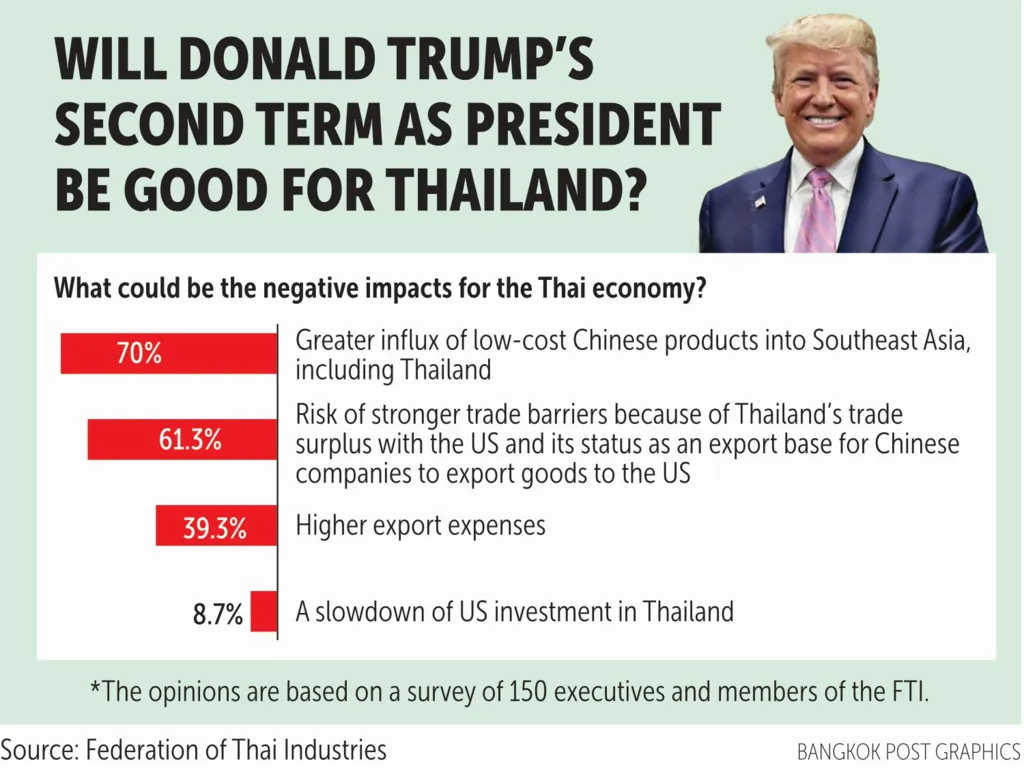Thailand’s export-driven economy is facing serious pressure from the looming threat of steep U.S. tariffs. Under former President Donald Trump’s proposed “reciprocal” trade policy, Thai goods could face tariffs as high as 36%—the highest among Southeast Asian nations. The Thailand Trade Tariff Risk is now a critical concern for industries and policymakers alike.
High Exposure to a Major Market
The United States currently accounts for 18% of Thailand’s exports, contributing 2.2% to the nation’s GDP. This deep dependence on U.S. markets makes any tariff shift economically painful. In total, 9% of Thailand’s GDP is exposed to the risk of U.S. trade penalties, with a potential 1.1% contraction if full tariffs are enforced.
Read Also: Thailand Tariff Avoidance Strategy: A Risky Gamble to Win Over US?
Compared to other countries in the region, like Vietnam (20%), Malaysia (25%), and Indonesia (32%), Thailand’s proposed 36% rate leaves it with a stark competitive disadvantage in one of its largest markets.
Vulnerable Sectors on the Line of Thailand Trade Tariff Risk

The industries most at risk are some of Thailand’s most important employers and economic drivers. These include:
-
Automotive and machinery
-
Electronics and semiconductors
-
Rubber, plastics, and steel
-
Textiles and processed foods
These sectors have already struggled with post-pandemic slowdowns and global supply chain disruptions. A new wave of tariffs could push them into deeper trouble.
The Economic Cost of Thailand Trade Tariff Risk: Up to $25.8 Billion
If the proposed tariffs are implemented, Thai export revenue could fall by $25.8 billion (900 billion baht). Government officials have more conservative—but still alarming—estimates of $7–8 billion in losses, especially if the tariff rate stays in the 32–36% range.
The shock isn’t just theoretical. Several manufacturers, especially in automotive and electronics, are already rethinking operations. Some companies are delaying investments or exploring relocation options to countries with lower tariff exposure.
Read Also: Adaptive Moves in Response to Thailand Inflation & Policy Flexibility
Geopolitical Fallout and Alternative Markets
The tariff threat comes amid broader geopolitical tensions, with the U.S. increasingly targeting Southeast Asian trade partners over perceived imbalances. Thailand’s lack of a free trade agreement (FTA) with the U.S. exacerbates its vulnerability unlike Vietnam, which has seen tariffs drop under the U.S.-Vietnam Trade and Investment Framework Agreement (TIFA).
To mitigate risks, Thailand is accelerating trade diversification efforts:
- Expanding exports to China, now its largest trading partner (20% of total trade)
- Boosting ASEAN trade, particularly with Cambodia and Myanmar for lower-tariff re-exports
- Negotiating the EU-Thailand FTA, stalled since 2014 but now back on the table
However, these shifts take time. Electronics giants like Delta Electronics warn that even partial tariff enforcement could force supply chain relocations to India or Mexico within 12–18 months. This could possibly mean a costly disruption for Thailand’s industrial base.
Employment, Investment, and Long-Term Strategy
With manufacturing accounting for a major portion of Thai jobs, the risk extends beyond macroeconomic data. A tariff-triggered slowdown could lead to massive job losses and stalled wage growth. The Thailand Trade Tariff Risk also dampens investor confidence, potentially affecting FDI flows.
Moreover, if the tariffs push Thai goods out of U.S. supply chains, regaining market share could take years—even if policies change in the future.
Thailand Trade Tariff Risk Calls for Diversification and Policy Response
Experts suggest Thailand must act fast. The nation can start diversifying export markets, boosting domestic demand, and strengthening regional trade pacts like RCEP and ASEAN+1 agreements. There’s also a call for diplomatic engagement with Washington to seek exemptions or reduced rates. Even though the nation's path forward demands resilience, the Thailand Trade Tariff Risk is clear. The threat of U.S. tariffs is a structural challenge for Thailand’s economic future.







